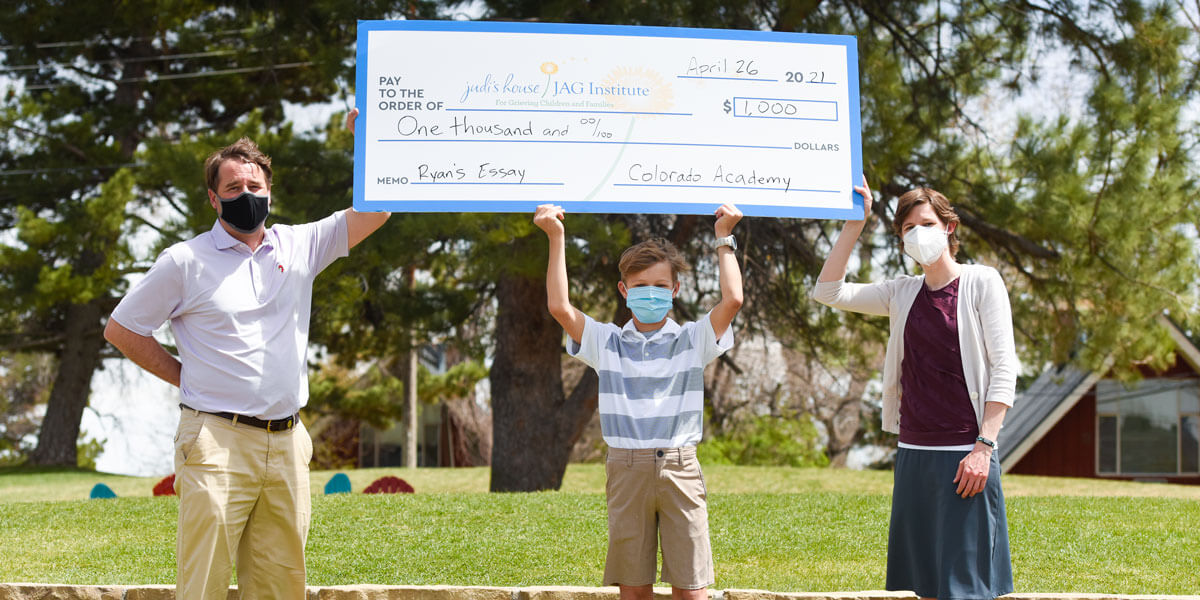When the annual Philanthropy Essay assignment came due, Ryan Baumbusch wasn’t optimistic about how he would fare in this Sixth Grade competition.
“I’m good at math, but my strengths are not in writing,” he says. “I figured I had a super-low chance of winning.”
But those who read the beginning of Ryan’s essay may think he misjudged his skills. Here is what he wrote:
“Just imagine you are 11 years old and your mom has cancer. Then COVID-19 hits. People are telling you to be ready for your mother’s death. Then it happens. She died. And you are only 11. You have to navigate life without a mother. This is what happened to my baseball teammate about a month ago.”
In his essay, Ryan explains why he would like some of the Middle School philanthropy funds donated to Judi’s House, a nonprofit devoted to helping children who are experiencing bereavement after the loss of a family member. From the 76 essays submitted by Sixth Graders, Ryan’s was chosen as the winner by the Colorado Academy Alumni Board.
“The work done by the Sixth Graders on their philanthropy projects is so impressive,” says Alumni Board Member, Terrie Dickinson Warren ’73. “It made choosing a single project extremely difficult. I voted for Ryan’s project, Judi’s House, because experiencing the loss of a loved one is so sensitive and emotional, especially for a child who loses a parent.”
It’s clear from Ryan’s essay that he understands how to move people with his words. His essay ends with these words:
“I hope you consider Judi’s House and are left with the same message that I was left with. If you go to Judi’s House alone in darkness, you will come out in the light.”
The origins of the Philanthropy Essay
As Middle School Core and English teacher Matt Olmstead explains, the philanthropy assignment has multiple goals. Students start by doing research to identify an organization they want to support. Then, each student has to reach out to that organization to further research its mission. Finally, they write a persuasive essay, using tools they learn in class—pathos, ethos, and the basic mechanics of writing.
“We teach students that they must communicate what they feel for an organization to others,” Olmstead says.
The essay also serves to provide a foundation for future service projects CA students will do. All Seniors are required to do a Community Impact Project to graduate. Ryan had been introduced to Judi’s House by his older brother who volunteered there.
“This is an opportunity to start learning about organizations that do so much good for the community,” Olmstead says. “Maybe students will find a place they are passionate about and return to volunteer there when they are in Upper School.”
The essay writing contest was born after a conversation between Olmstead and his wife, Lyz Firman Olmstead ’95, when she was serving on the Alumni Board.
“The Board felt disconnected from students, so Lyz and I brainstormed, and we came up with this idea,” says Olmstead. “The Alumni Board is the final judge of the essays, and they love seeing the students’ work.”
In some cases, the Sixth Graders spark a network of giving. Alumni Board members have been known to make donations to organizations that do not win the competition, simply because they are so moved by a student’s passionate argument.
For Ryan, there were many lessons learned. “Everyone always says, if you put more work into something, it will be worth it,” he says. “Now that I look back on it, I put a ton of work into it, and it really did pay off.”

The Middle School Philanthropy Board
The essay contest is only half of the Middle School philanthropy mission. Advised by teachers Sue Counterman and Erin Carlson, eight Middle School students serve on the Middle School Philanthropy Board. Each year, they research dozens of Colorado nonprofits and narrow the list of possible beneficiaries of Middle School philanthropy. The funding for their generous giving comes from an endowed fund established by an anonymous donor, who wanted CA students to experience learning about philanthropy.
Ultimately, the Board presents descriptions of five organizations to the entire Middle School and students vote to choose two organizations to receive donations. This year, students voted on these five:
- Underdogs Animal Rescue
- 350 Colorado (a grassroots network focused on climate change)
- American Foundation for Suicide Prevention
- Ace Scholarships
- Food Bank of the Rockies
In their final vote, the Middle Schoolers chose to support 350 Colorado and the Colorado Chapter of the American Foundation for Suicide Prevention.
“What I love about this is being the ‘connective tissue,’” says Counterman. “Some students just have a passion to give, and I love connecting them to the resources, where they can learn about philanthropy on a deeper level and see the impact their gift has when their charity is chosen. I think it creates a lifetime commitment in some cases.”
This year, the Middle School Board also wanted to be responsive to current events, after the shootings at the Boulder King Soopers. The Board decided to donate a portion of their funds to the Colorado Healing Fund, to support the needs of victims, families, and the community affected by the supermarket mass shooting. Board Member Jack Shapiro, who is in the Sixth Grade, volunteered to notify the Colorado Healing Fund about the gift.
“I got an email back from the organization within an hour,” Jack says. “It just makes you feel really good about what you have done. And it reminds you that CA is a selfless place, where people work tirelessly to help others with their problems.”
